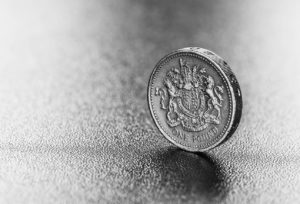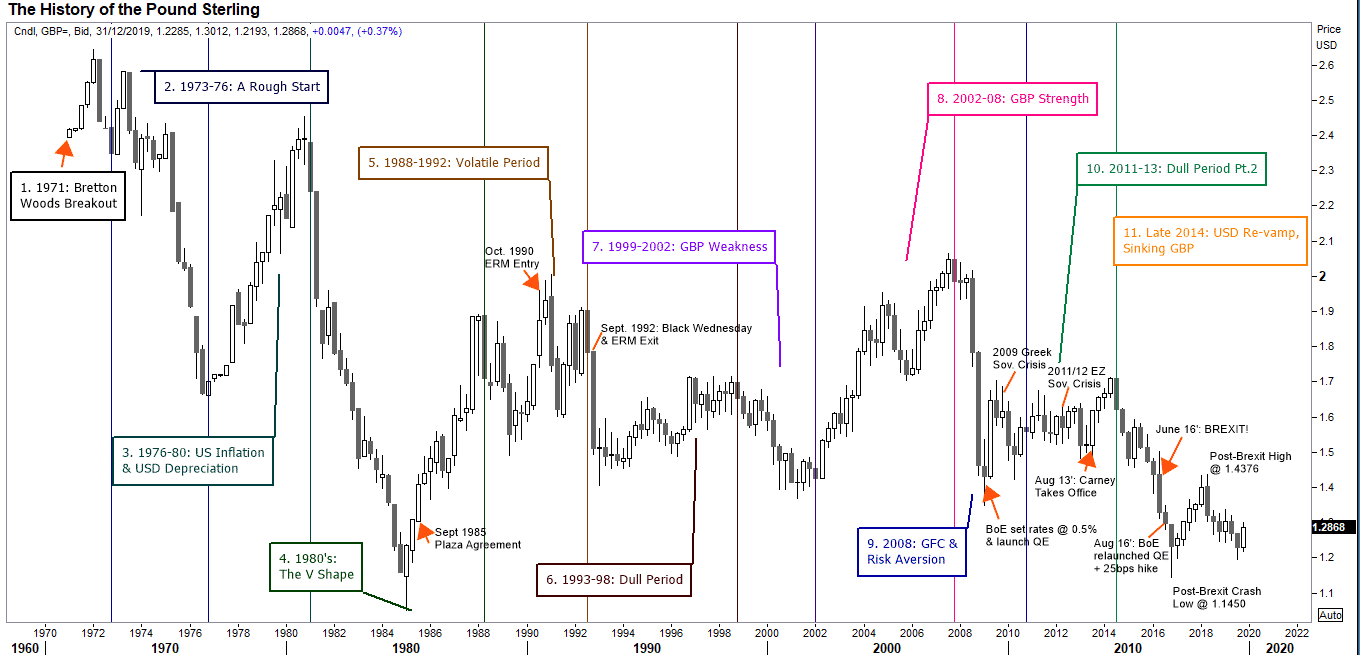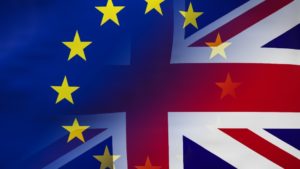In this article we are going to look at the British Pound, the world’s oldest, still used currency. We will explore the Pound in a historical context, looking at its roots in the Forex market, we will follow the Pound into the modern era and on into the recent Brexit saga. We will also look at the events that can impact the Pound on a day to day basis and in the longer-term, and also what lies ahead for the U.K.’s currency.
- What is Forex?
- The Pound defined
- What impacts the GBP Forex rate?
- The Pound in a historical context
- GB Pound in the modern era
- The Pound in the Brexit era
- Sterling crash in 2022
- The future for Sterling
What is Forex?
Forex Market Definition: A market to exchange one currency for another for immediate or future delivery.
Before we can take a look at the GB Pound specifically, we should first place the Pound in the context of the financial market that we are looking at, the Forex market. The Forex markets are also called FX, foreign exchange and currency markets. They are non-centralized, global markets for trading different currencies. You can see our broad History of the Forex Markets here which should help with the historical view of how the Foreign Exchange markets developed.

Trading forex comprises buying one currency and simultaneously selling another. The primary centre of the FX Market has been London since the end of Bretton Woods given its central geographic position. Forex is traded over the counter (OTC) and on exchange (FX futures after traded on the Chicago Mercantile Exchange (CME)). It features a large turnover, between $5 and $7 trillion per day and is very liquid, meaning that two-way prices are available, and it is relatively easy to open and close market positions.
The FX market is global and is a 24-hour market, 5.5 days a week (opening in Asia on Monday morning and closing in the US on Friday evening). It also has low margins, tight spreads and a large scope and variety of participants. These would include; Central Banks, Investment Banks, Multinational Companies, Hedge Funds, Investment Managers, FX Brokers, Importers and Exporters, speculators/ leveraged Retail Investors.
The Pound defined
The Pound is the common name for the currency of the United Kingdom (U.K.), which is officially known as Pound Sterling, sometimes just Sterling.
In Forex terms its ISO Code is GBP. The Pound is the fourth most traded currency globally on the Forex market, after the so called G3 currencies, the US Dollar the Euro and the Japanese Yen. Alongside these three currencies and the Chinese Yuan, the Pound makes up the five currencies that input into the calculation for the International Monetary Fund Special Drawing Rights. Furthermore, the Pound comes in at number five on the list of currencies held in global reserves. The symbol for the Pound is £, which derives from the letter L, from the Roman word libra, meaning pound (in weight).

In Forex markets, the Pound against the US Dollar exchange rate is often referred to as “Cable”. This comes from the fact that in the 1800s the GBPUSD Forex rate was transmitted between the US and U.K. via a transatlantic cable.
What impacts the GBP Forex rate?
The five main factors influencing the short-term value of the Pound (GBP) in Forex markets are:
- U.K. economic conditions and data
- Global economic conditions and data
- U.K. interest rate moves and expectations
- Interest rate differentials
- Geopolitical influences
A stronger U.K. economy, or the perception of a stronger economy as indicated by short term economic data has a direct influence on the currency, with an improving economy encouraging a stronger Pound. Conversely, a weakening economy or weaker economic data tends to lead to a weaker Pound. Furthermore, changes in the global economic outlook can also impact on the Pound Sterling, though these impacts can sometimes be difficult to predict and will depend upon the relative position of the U.K. economy, in relation to the global economic backdrop.
In addition, the level of U.K. interest rates, which are set by the U.K. central bank, the Bank of England also impact on the value of the Pound in Forex markets. It tends to be the case that higher interest rates, or the perception of higher interest rates will lead to an appreciation in the Pound. Conversely, a lowering of interest rates or the expectations of interest rate cuts will tend to see a depreciation in Sterling on Foreign Exchange markets. Therefore, monitoring the activity of the Bank of England alongside speakers from the Monetary Policy Committee (MPC) of the Bank of England, is essential in understanding movements in the Pound on currency markets.

In addition, all Forex market are relative value, that is to say one currency is exchanged for another currency. This means that the differential between U.K. interest rates and interest rates of other countries influences the level of the Pound against those other currencies.
Finally, geopolitical impacts from the likes of politics, trade wars, terrorism and the weather can impact all global financial markets, with the Foreign Exchange markets and the Pound no exception.
In the longer term, the Pound Sterling’s value is impacted by:
- The longer-term U.K. economic condition
- The longer-term global economic condition
- Long-term geopolitical shifts
The longer-term influences on the Pound are similar to the short term influences, but we would be looking at the longer-term shifts in the U.K.’s economic outlook and also the longer-term global conditions. In addition, bigger picture, structural geopolitical shifts could have an impact on the Pound’s value against global currencies.
The Pound in a historical context
We have produced a comprehensive History of the Forex Markets here, which you should read to give an understanding of where the Pound sits in the broader framework of Forex Markets. As the planet’s oldest still used currency, the Pound has seen the comings and goings of The Gold Standard Monetary System, the Bretton Woods System, the Smithsonian Agreement, the Plaza Accord, the European Exchange Rate Mechanism, the birth of the Euro and the Brexit divorce from the EU.
In this section, however, we are going to look more specifically at the historical context for the Pound from ancient times to decimalisation in the early 1970s.

The Pound dates back to the 8th Century, back to Anglo-Saxon times, where 240 silver pennies was the equivalent of one pound in weight of silver. This then developed into the current U.K. currency, the Pound Sterling, from the weight of the Sterling Silver. Silver was the legal basis for the currency until 1816, though during Tudor times the silver coins were debased on a number of occasions. From 1816, the Gold Standard was officially adopted, with the Bank of England issuing legal tender notes valued relative to gold.
The Pound was used extensively on a global basis during the 18th and 19th Centuries as the British Empire grew. In Canada, Australia, India, the Caribbean and South Africa. The Gold Standard was suspended at the start of World War One in 1914, with a new version reinstated 1925, but then abandoned in 1931 during the Great Depression.
During World War Two, in 1940, the Pound was pegged to the US Dollar, at $4.03, eventually devalued in 1949 to $2.80.
GB Pound in the modern era
The Pound has also been on a rollercoaster in the more modern era, which really kicked off with decimalisation on 15th February 1971. After the move to a decimal system, the Pound then went on to free float against global currencies from August 1971 after the breakdown of the Breton Woods System. Sterling then managed to ride out the 1976 Sterling Crisis, then an aggressive rally and selloff in the Thatcher era of monetary policy that saw GBPUSD rally to $2.40 in 1979 and plunge to $1.03 in 1985.
Then saw a move to shadow the German Mark from 1988 and then shadow the European Currency Unit (ECU) as part of the European Exchange Rate Mechanism (ERM). However, the Pound crashed out, leaving of the ERM on Black Wednesday, 16th September 1992 after aggressive speculation against the Pound, famously by the speculator George Soros.
The U.K. government then decided to opt out of adopting the Euro, which fully came into being on 1st January 1999. The Pound also suffered during the first part of the 2008-2009 global financial crisis, plunging in value against both the US Dollar and Euro.

The Pound in the Brexit era
On the 23rd June 2016 the U.K. European Union Membership Referendum took place, now commonly known as the Brexit vote. The result was for the U.K. to leave the European Union, which immediately established a new era for the Pound’s relationship with global currencies. The Pound immediately weakened against the Euro by 5% with GBPEUR moving from 1.30 down to 1.23, then by October lower to 1.1450, a 14% depreciation. On the same timelines, the Pound versus the US Dollar, the Cable Forex rate (GBPUSD) went from 1.46 to 1.37 overnight and to 1.22 by October 2016, a 16% decline.

After winning a landslide victory in the December 2019 general election under Boris Johnson, the Conservative Party secured a Brexit deal with the EU on 31st January 2020. Despite some concerns throughout 2020, the UK completed its separation from the EU on 31st December 2021.
During this phase, the Pound gained versus both the Euro and the US Dollar, despite a significant sell off in Q1 2020 in reaction to a strong US Dollar in the wake of the global spread of COVID-19.
GBPUSD strength resumed in 2020 and carried forward into 2021, with the extremely impressive rollout of the UK vaccination program.
Sterling crash in 2022
The US Dollar was king in 2022, showing broad strength across all major currencies. This was a reaction to two interconnected events. First, it was seen as the ultimate safe haven currency during the “risk off” phase and global bear market in equities, driven by the war in Ukraine leading to spiraling higher prices in energy and other commodities, particularly food. Secondly, the US Federal Reserve has been the most hawkish and aggressive of the world’s central banks, pushing up interest rates at a faster pace and in bigger steps than elsewhere. This has produced a notable interest rate differential in favour of owning the US Dollar.
This activity saw a big sell off in GBPUSD, although much of this was initially due to a stronger US Dollar. However, the fallout from the UK political “partygate” scandal in the U.K. saw political uncertainty as Boris Johnson was forced to resign as Prime Minister, which saw the already fragile Pound not only move lower against the US Dollar through the summer of 2022, but also weaken versus other major currencies, notably the itself weakened Euro! Shortly after becoming Prime Minister in September, however, Truss and her Chancellor of the Exchequer, Kwasi Kwarteng unveiled a mini-budget on 23rd September. This saw multiple tax cuts announced and the reversal of the April 2022 increase in National Insurance. The financial markets reacted extremely negatively to this step and within days the Pound was in freefall, with GBPUSD nearly hitting parity, hitting an all-time low, also posting significant losses versus all other currencies. Long-term interest rates also spiked higher and the Bank of England had to intervene in the Gilt market, that was in freefall and threatening the financial stability of the U.K. The intervention by the Bank of England, the resignation of Liz Truss and the appointment of a new Tory party leader and Prime Minister, Rishi Sunak saw a rebound for the Pound
The future for Sterling

The short-term future for the Pound is unclear after the above mentioned chaos, but for now the downside risks seem to have been eased.
In the medium-term, however, what will be key for the pound is the continuation and the pace of the ongoing unwind of the super easy monetary policy and how hawkish the Bank of England remains. Plus, how quickly the inflation rate starts to move lower and also if the Bank of England can achieve a soft landing, that is not to take the U.K. economy into recession. This seems unlikely, so the key question is how dovish, if at all, the Bank of England moves, if the U.K. economy goes into recession and how deep that recession might be. The Bank of England have already warned that this could be the deepest recession ever. In early November 2022 the Bank of England warned that the U.K. is facing its longest recession since records began, with the economic downturn expected to extend well into 2024. Inflationary pressures are of course subject to staying high, with the big unknown still the path of the Ukraine war and intertwined with this, the level of energy prices.
Where the Pound sits in this environment, only time will tell.
In conclusion
In this article we have reviewed what the foreign exchange market is and what the Pound Sterling is. We have also explored what it is that impacts on the value of the Pound against other currencies on Forex markets and looked at the U.K. currency in a historical context, during the modern era and during the current Brexit phase. As for the future for the Pound, one thing is almost certain, it will NOT be dull!